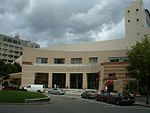Eddie Pellagrini Diamond at John Shea Field

Eddie Pellagrini Diamond at John Shea Field was a baseball stadium in Chestnut Hill, Massachusetts. It was the home field of the Boston College Eagles baseball team from 1961 to 2017. The stadium held 1,000 people and was named after Commander John Joseph Shea, USN, a former football player (1916–1917) at Boston College, who died on September 15, 1942, when the aircraft carrier USS Wasp was torpedoed and sunk during the Guadalcanal Campaign in World War II. In 1997, the diamond was named for Eddie Pellagrini, head coach of the Eagles for 31 years and the coach of the team when the field opened in 1961.Shea Field was also home to many tailgaters during home football games at the adjacent Alumni Stadium. The Boston College baseball team played its final game at Shea Field on May 20, 2017. The team moved to a new baseball stadium, on nearby Brighton Campus, in spring 2018. Boston College's new Athletics Field House, an indoor practice facility for football and other varsity and intramural sports, is currently being constructed on the site of the former Shea Field. It is expected to open in August 2018.
Excerpt from the Wikipedia article Eddie Pellagrini Diamond at John Shea Field (License: CC BY-SA 3.0, Authors, Images).Eddie Pellagrini Diamond at John Shea Field
Beacon Street, Boston Brighton
Geographical coordinates (GPS) Address Nearby Places Show on map
Geographical coordinates (GPS)
| Latitude | Longitude |
|---|---|
| N 42.334277777778 ° | E -71.163111111111 ° |
Address
Fish Field
Beacon Street
02138 Boston, Brighton
Massachusetts, United States
Open on Google Maps







